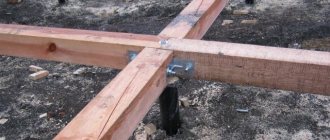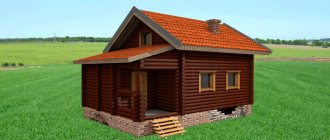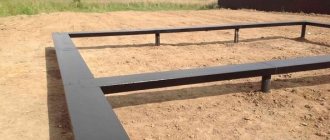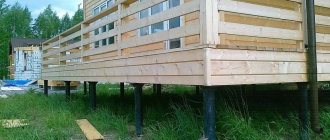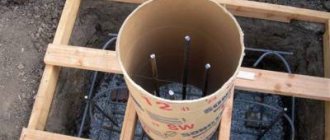A solid foundation during the construction of houses is a guarantee of their stability, especially on problematic soils. Arranging a foundation on screw piles is one of the most budget-friendly options, but this design requires additional reinforcement with concreting, which will allow it to withstand a load of up to 3 tons.
The need to fill screw piles with concrete is often questioned, and yet this particular technological operation is the best method to increase the load-bearing capacity of structures and ensure their corrosion resistance. In addition, this technology will protect the piles from destruction in winter, which is possible when water gets inside the pipe and its subsequent freezing, and will also ensure the safety of the foundations of neighboring buildings during construction work in densely built-up areas.
Is it worth filling screw piles with concrete?
Often the installation of screw piles is combined with internal concreting, which is done after the pile has been driven and before the cap is installed. This is done in order to:
- Prevent moisture from penetrating into the wellbore, as it increases the rate of corrosion propagation inside the product. And ice during thermal expansion can damage and change the shaft of the pile.
- Strengthen the degree of rigidity of the structure.
Advantages and disadvantages of pouring concrete into piles
Strengthening a screw pile with concrete from the inside allows you to increase the load-bearing capacity of the trunk by thirty percent, and therefore this method can be used to save on the installation of a screw-pile foundation. By pouring concrete into piles, products can be used with smaller diameters due to the fact that the price of the concrete used will be several times less than the price of the pile.
Many experts recommend pouring concrete on piles when the installation of a pile foundation will take place on watery soil. Also in large cities, when every meter is important during construction, this is an excellent way to strengthen the foundation. Piles are also poured with concrete when constructing three-story houses or buildings with the same parameters and weight.
However, despite the many advantages, there are still many opponents of this procedure, since they believe that concreting can harm the structure, because iron and concrete have different coefficients of thermal expansion. In addition, after some time, the concrete begins to crack, in which air and moisture remain, which accelerates the destruction of the structure. Such arguments are partly true, however, if there is no concrete in the pile, then ice will form inside, which also provokes corrosive processes and expands with temperature changes.
What is important to remember when concreting piles from the inside
- There is no need to fill in a ready-made solution, since there is little chance that it will completely lie down and voids will not form inside. It is worth pouring dry sand concrete into the piles, which over time will be saturated with water and become stone.
- As a rule, to concrete one meter of a pile with a diameter of ninety millimeters, you will have to use twelve kilograms of the substance.
- In winter, it is worth adding an additive to the mixture.
When not to concrete piles
If the foundation is not installed for a long time, an example is construction trailers. Piles that are filled with concrete are difficult to dismantle and are not suitable for reuse, as can be done with hollow piles. When piles of sixty millimeters are installed, the expansion of ice in such piles does not harm the structure, since there is not much of it inside. When installing piles with a wall thickness of eight millimeters or more, it is not economically feasible to fill them with concrete.
Justification for the need for concreting the shaft of a screw pile
The article discusses the need for concreting the shaft of a screw pile, the joint work of steel and concrete, and alternative methods of filling the pipe.
The content of the article:
Procedure for filling the cavity of a screw pile shaft
Often customers doubt the need to fill the shaft of a screw pile. The reason lies in the fact that, without being a specialist, it is quite difficult to assess all the benefits of the procedure. However, according to technology, injection of solution into the pile shaft is one of the important processes.
It is done as follows: after cutting down the area with the installation hole, concrete or cement-sand mortar is usually poured into the screwed pile. It is advisable to use a funnel: the solution will not spill, and you will be able to better control the flow of material.
After pouring, it is recommended to compact the solution using a metal rod (this can be a piece of reinforcement). Of course, it is unlikely that it will be possible to eliminate all remaining air cavities in this way, but still the procedure will significantly reduce their number. After this, you can mount the head and continue work.
Concrete piles are more susceptible to corrosion - myth or reality?
It would seem that the technology is simple and necessary, but its feasibility, however, has been questioned. Some companies do not use concreting of the pile shaft, since, from their point of view, it reduces the service life of the foundation. This opinion is supported by the fact that metal and concrete have different coefficients of thermal expansion. Because of this discrepancy, microgaps are allegedly formed in which moisture accumulates, and in the presence of oxygen access, corrosion proceeds at an accelerated pace.
These arguments have no basis in reality and are easily refuted. The coefficients of linear thermal expansion of steel and concrete differ little from each other, and the existing insignificant difference cannot cause a conflict of materials. Structures made of steel and concrete behave similarly to homogeneous structures both at subzero temperatures and under non-stationary thermal conditions. This is what makes it possible to use such materials as reinforced concrete and pipe concrete.
Even if cavities remain in the concrete solution, the absence of the possibility of air penetration will minimize the likelihood of condensation forming in them on the inner wall of the trunk. When pouring the cast solution, air is displaced from the barrel and the formation of cavities becomes unlikely. The main advantage of this technology is that concrete is an alkaline medium (pH more than 7 units) and prevents metal corrosion processes. For example, in reinforced concrete, the reinforcement is preserved due to the presence of a protective layer of concrete several centimeters thick, which ensures the presence of an alkaline environment around the steel rods. Corrosion of reinforcement in reinforced concrete is possible only in the presence of highly aggressive environments or a change in pH level downward due to carbonization. This is only possible in open contact with air or water. Therefore, water that gets into the cavities, cracks and gaps of the hardened concrete inside the pipe does not change the pH level. Concrete does not have a negative effect on the metal, but is a protective medium.
Moreover, filling a steel pipe with concrete increases the rigidity of the elements, increases the local stability of the walls and dampens vibrations.
Alternative filling of the shaft cavity of a screw pile
For working with concrete, the most favorable temperature is between +15° and +25℃. If antifreeze additives are used, this range expands to +5℃. It is worth recalling that at negative air temperatures, the concrete or sand-cement mixture must be constantly heated, which causes additional costs, so a dry sand-cement mixture can be used to fill the shaft of a screw pile.
As in the case of concrete or sand-cement mortar, after cutting off areas with a technological hole, it is poured into the pile through a funnel and then compacted.
The sand-cement mixture, like concrete mortar, “squeezes out” air, and the presence of cement ensures the creation of an alkaline environment when water enters. All this thereby prevents the occurrence of corrosion processes on the inner surface of the pipe.
If, despite all the above arguments, you are still wary of this procedure, then you should use piles with a wall thickness of 6 millimeters or more. Only in this case is it permissible not to fill the barrel, provided that the tip is completely welded in accordance with paragraph 9.2.2. SP 28.13330 “Protection of building structures from corrosion.”
Preparation
It is necessary to pre-prepare the construction site before the arrival of the team of screw pile installers; it is necessary to take care in advance of removing foreign objects, building materials, garbage, and old buildings to be demolished from the site.
In winter, snow should not be removed from the site; this will prevent deep freezing of the soil or be removed in the morning on the day of installation, but not earlier. It is also very desirable to provide lighting for the site in the evening.
Availability of communications: 220 V electricity is required, water is needed at least of technical quality, it will be needed to prepare the cement-sand mixture used for concreting the piles.
Obstacles when installing screw piles
It is good when the installation is carried out on a bare, flat plot of land without buildings, fences and trees, and the soil at the construction site is homogeneous and does not have inclusions of stones, large roots, buried construction waste, etc. The installation of the pile slows down somewhat when a fence, walls, trees, or pillars are located close to the installation point of the screw pile.
It is also impossible to screw the pile closer than 30 cm from an existing wall or fence, and if you plan to screw the pile in the immediate vicinity of a large tree or an unuprooted stump, then you need to take into account that the roots, as a rule, diverge underground underground.
Sometimes, during the process of driving the pile, it turns out that stone inclusions lie deep in the soil. Small stones, up to 5 cm in size, do not have a negative effect on screw piles.
Large stones falling directly in the path of the pile make further twisting impossible. Medium-sized stones, 5-10 cm in size, as a rule, although they do not prevent further twisting of the pile, cause a displacement of the tip of the pile to the side, which in turn causes some deviation of the pile axis from the vertical.
Removing obstacles
If a large stone gets in the way of the pile, at a depth of 1.5 meters or more (i.e. below the freezing depth of the soil), then you can not tighten the pile further and leave it as is, especially since the stone lying under the pile will “help” it » carry the load and distribute it throughout the soil thickness. This is applicable if in the depths of the soil there are not single stones, but a continuous stone belt.
Or you will have to unscrew the pile back, dig a hole with a shovel at the place where it was installed, throw away the stones and continue tightening the pile. The soil removed from the pit is filled back in and compacted around the pile.
Medium-sized stones in the installation of piles can lead to some inaccuracy; here you will have to choose: either some inclination of the pile and precise installation of the top, or strict verticality but some deviation towards the top.
If concrete slabs or blocks, remains of old foundations, or large construction debris lie deep in the soil, then under such conditions, installing a pile becomes impossible.
Anti-corrosion coating
It is very important to choose the right type of anti-corrosion coating in order to minimize this negative effect. Indeed, regardless of the type of soil, when a pile is screwed into it, the coating is erased on the tip of the pile, as well as on the front cutting edges of the pile blade.
However, these parts of the pile will eventually end up deep in the soil, well below the surface of the earth, because corrosion in the depths of the soil is very difficult and should not be feared. But it is most necessary to reliably protect from corrosion that part of the pile that is located at the boundary of the earth and air, as well as in the upper ground layer; in this place, corrosion occurs most actively on unprotected metal.
A metal primer-type coating can be used in the construction of foundations for temporary structures (houses, decks); here the problem of corrosion aging of the foundation is not acute.
Simple single-layer types of anti-corrosion coatings - cold galvanizing, coating with bitumen mastic can be used in the construction of simple and low-impact structures, such as fences, gazebos, canopies.
If the soil is slightly abrasive, for example plastic wet clay, peat, and you are building a long-term critical structure, you should choose at least a combined double coating consisting of a layer of cold galvanized, on top of which a layer of bitumen mastic will be applied. This combination of anticorrosive will perfectly protect your foundation for many years, and the plastic wet clay practically does not damage the side surface of the pile shaft when twisted.
| Soil characteristics | Corrosion penetration depth per year (mm) (uncoated) |
| Sands | 0,00320 |
| Clay | 0,00292 |
| Ily | 0,0327 |
| Ground-water boundary | 0,0814 |
When using screw piles on abrasive soils - sandy loam, sand and soils with small stones, artificial bulk soils containing crushed stone, anti-corrosion protection is required. Here you need a coating that includes placing a heat-shrinkable film (tube) over the anticorrosive layer.
This durable polymer film covers the pile very tightly, has high strength and protects the underlying layers of anti-corrosion coating from abrasion when twisting.
Installation of screw piles
It must be borne in mind that the very method of installing screw piles, namely twisting, presupposes, despite all the thoroughness of the work, some slight installation inaccuracy. This is in contrast to burying or pouring concrete, where the builders first position the pile with precision and then bury or pour it.
Screw piles are screwed into the ground gradually, but the pile, passing through the layers of soil, undergoes some displacements due to some heterogeneity of the soil, solid inclusions present in it, etc. or when the pile hits rocks or large roots. The upper edge, after screwing all the piles into the ground, is set using a laser or hydraulic level, and, if necessary, by cutting off the upper ends of the piles.
In some types of soil, most often in coarse sand, an effect such as stopping the pile is possible. If, despite the efforts of about 4-5 people twisting the pile with a 3-meter lever, during the process of twisting it into the ground it has reached such a dense layer of soil that it can no longer be screwed in, then its further twisting is stopped.
Technology of pouring concrete into screw piles
A concrete foundation on supports driven into the soil by screwing is considered a strong and reliable foundation. Concreting of screw piles is carried out to increase the strength characteristics of the base, since the internal cavity of the structure is hollow, condensation can form there and, as a result, the metal is subject to corrosion. Filling with cement with fine fractions or a sand-cement mixture serves as a barrier to the penetration of moisture into the trunk and increases the bending strength of the structure. Mounting a screw-type foundation is considered one of the most cost-effective construction methods.
In what cases is a concrete grillage used?
Concrete grillage is one of the most reliable methods of strapping. It has two key advantages - concrete strength and resistance to extrusion forces.
A grillage on concrete piles is suitable for the construction of houses made of brick, foam block, gas silicate and other non-plastic materials. It eliminates deflection under peak loads.
In addition to the construction of houses, pile grillage is used in other cases:
- If you need to give the base a more aesthetic appearance. Siding can be installed on a concrete base; it can be repainted or plastered.
- If necessary, insulate the space under the building or extend any communications.
- When building fences. In this case, the grillage is used both for aesthetics and for installing brick pillars.
Fluid soils and very deep peat bogs are considered contraindications for installing screw piles. It is not recommended to install piles in rocky foundations. For rocky soils, screw piles with a cast tip can be used.
Concrete foundations on screw piles are used mainly for the construction of small country houses or cottages.
Video about a concrete foundation on screw piles:
The feasibility of concreting screw piles
A solid foundation during the construction of houses is a guarantee of their stability, especially on problematic soils. Arranging a foundation on screw piles is one of the most budget-friendly options, but this design requires additional reinforcement with concreting, which will allow it to withstand a load of up to 3 tons.
The need to fill screw piles with concrete is often questioned, and yet this particular technological operation is the best method to increase the load-bearing capacity of structures and ensure their corrosion resistance. In addition, this technology will protect the piles from destruction in winter, which is possible when water gets inside the pipe and its subsequent freezing, and will also ensure the safety of the foundations of neighboring buildings during construction work in densely built-up areas.
Justification for the need for concreting the shaft of a screw pile
Concreting screw piles has a beneficial effect on the mechanical properties of the structure, helping to increase rigidity, strength, and elasticity. Nevertheless, opponents of such reinforcement point to the danger associated with the difference in the thermal expansion coefficients of metal and concrete. In their opinion, this can lead to the formation of microcracks in which moisture will accumulate, which will lead to the activation of corrosion processes.
But such an objection is unlikely to find many supporters, since it is refuted by practice. Indeed, the high strength characteristics of building materials such as reinforced concrete or pipe concrete are beyond doubt, so there is no reason to believe that filling screw piles with concrete can negatively affect their corrosion resistance.
In addition, for the development of corrosion, in addition to the presence of moisture, constant access of oxygen is necessary, and the concreting procedure displaces air from the pile shaft. It should also be taken into account that concrete is an alkaline environment, favorable for exposure to ferrous metals, and therefore does not have any noticeable chemical or physical effect on metal structures.
Procedure for filling the cavity of a screw pile shaft
So, we are convinced that the question of whether screw piles need to be concreted should be resolved positively. How to perform this operation correctly with the best result? In fact, this technology does not require the use of special equipment or special techniques. It is produced as follows:
- After screwing the pile, it is necessary to cut off the area with the mounting hole.
- Concrete solution is poured inside the pile shaft, and to save materials it is recommended to use a funnel.
- After pouring, the solution is compacted, which can be done by hand, but it is better to use a piece of reinforcement for this purpose. This simple procedure will reduce the number of internal cavities.
- After the concrete mixture has hardened, the head is installed.
What is the best way to fill a screw pile and why? Typically, a sand-concrete mixture is used for this, which has a tendency to shrink, and the pouring itself is carried out slightly below the trim level. When concrete hardens, a small depression is formed, so for high-quality pouring, you should add cement or powdered concrete to the pile.
Is it necessary and how to treat the soil under a pile foundation - sand, gravel, geotextiles?
I'm going to put a log garden house on a pile foundation. The soil is clayey, and now there is grass on it. I saw photos of how they make pile foundations - they just leave all the grass as is. It seems to me that in this case, after the building is erected, when the basement is closed, all this grass will turn into a compost heap under the house. Somehow this is “not comme il faut,” it seems to me.
So I see this solution: Use a tractor to remove the top layer of soil, approximately 20 cm, then order 10 cubic meters of sand and make a sand cushion. With a building area of 36 squares, the thickness of the pillow will be 25-30 cm.
There is also such a thing as geotextiles - it prevents plants from sprouting from the soil, and on the contrary, sand does not go into the soil. But I don’t really understand what will happen to it when the piles are twisted into it - it seems that it will just get wrapped around the pile and the result will not be quite ice.
There is also crushed stone - I also don’t understand how it is better or worse than sand for preparing the soil for a pile foundation.
In the end, the questions are: 1. Is it necessary to do anything at all with the soil under the house? 2. What kind of pillow pie should it be? What thickness is required and what materials should I use?
I, Irina, became interested in your question and went looking for explanatory information. Here's how they explain it on one of the portals - A concrete solution is poured inside a screw pile to increase the load-bearing capacity. The screw pile also becomes more rigid in deflection under lateral loads, which is important when installing pile-screw foundations on slopes and hilly areas. The most important property is the prevention of corrosion in the shaft of the screw pile, since the concrete solution does not allow moisture to get inside the barrel and settle on the walls of the screw pile, as well as water to accumulate, which in winter can lead to rupture of the pile. Secondly, it will not allow the penetration of oxygen, therefore the pile will not be subject to corrosion, its service life will increase and the load-bearing capacity will remain unchanged.-
Do I have any doubts about the above positions? Yes, there is, and on every point. The load-bearing capacity is determined by the structure on which the mass of the house rests. And in our case, the load goes along the metal and “misses” the concrete mixture. Now, where can the lateral loads that frighten the readers of this narrative come from? And one more point - what is the use of concrete if it is not vibrated? Empty amorphous mass. What kind of load-bearing capacity is there? Now about aggressive moisture in relation to the metal of the pile, which concrete supposedly protects from... Every day they show on TV how the Crimean bridge is being built and how powerful piles are driven (or rather, vibrated with vibratory hammers from the German company Müller) into the salty water of the Sea of Azov. Somehow no one is afraid of corrosion at this strategic site. And why? Yes, because it is extremely insignificant. And corrosion on a dacha steel pile two meters long and under a load of 1-2 tons is just crumbs from the point of view of danger. For several years I was engaged in the creation of a vibratory driver of a new domestic design and personally loaded and removed X number of piles during testing. It is more correct to call them tongue and groove. And no one ever bothered with the topic of corrosion. The Japanese airport is built in the open sea on islands created by submerged piles. I don't hear anything about it rusting. To sum up what has been said, we can state the situation - the glass is half empty, the glass is half full. This is not the first time you and I, Irina, have encountered such situations.
News
Do screw piles need to be concreted from the inside?
Do screw piles need to be concreted from the inside?
8:14, March 25, 2016
Internal concreting of the pile shaft is carried out after its immersion before installation of the head. This procedure has two objectives:
- — preventing water from entering the cavity of the pile shaft (moisture accelerates corrosion from the inside, and ice can deform the shaft during expansion);
- — strengthening the rigidity of the structure.
Internal concreting: pros and cons
Injecting a solution into the barrel cavity increases its load-bearing properties by a third, therefore it can be used to save the installation of a pile-screw foundation. Internal concreting will allow the use of smaller diameter piles, provided that the cost of the concrete used is less than the cost of the pile.
We recommend pouring concrete in the following cases:
- — installation of a pile-screw foundation on watery soils;
- — screw piles in Moscow in urban areas, where it is important to gain every meter (in order to strengthen the foundation);
- — construction of a 2-3-story house or structure with similar mass parameters.
Opponents of internal concreting believe that cement can be harmful, since metal and concrete have different coefficients of thermal expansion. The second argument: over time, concrete develops cracks in which moisture and air accumulate, which activates the corrosion process. In part, these arguments are valid, but without concrete, ice will accumulate in the barrel cavity, which also contributes to corrosion and is subject to thermal expansion.
Tips for internal concreting of a screw pile:
- - there is no point in pouring the ready-made solution, since it is unlikely to lie completely without forming hollow niches. Fill in the dry mixture of sand concrete, it will become saturated with moisture over time, turning into stone;
- - on average, concreting 1 meter of 89 mm pile will require about 12 kg of mixture;
- — in winter it is better to add additives to the mixture.
In what cases is internal concreting not necessary:
- — when installing a foundation for a short period of time, for example, under a construction trailer. Piles filled with concrete are very difficult to dismantle, much less reuse. Hollow piles are unscrewed using mechanized equipment and reused (provided the blade and trunk are intact);
- — when installing piles with a diameter of 57 mm (for example, for a fence). Thermal expansion of ice in a pile of such diameter is not capable of causing harm due to its insignificant amount;
- — when installing piles with a wall thickness of 8 mm or more. Whatever the diameter of the pipe, internal concreting will not affect the quality of the foundation on screw piles: a pile with a diameter of 108 mm and a wall of 8 mm can withstand a huge load, and pouring concrete will not be economically feasible.
You can find out more answers to any questions about the pile-screw foundation from a professional. We not only produce screw piles in Moscow, but also provide foundation repair services of any complexity. By contacting us, you receive an absolute guarantee of responsibility, efficiency and quality of work performed.
Departments
Accounting
The accounting department has all the necessary information about the receipt of payments from Clients for services provided by GlavFundament (sale of screw piles, construction of foundations on screw piles, express geology, design of foundations on screw piles, civil and industrial facilities). Each Client has the opportunity to promptly receive information about the receipt of his payment to the organization’s account. The department's tasks also include issuing invoices and documents closing the reporting period.
Vasiliev Denis Alexandrovich
Corporate department
The Corporate Department is responsible for fulfilling contractual obligations to Partners for the supply of screw piles to the GlavFundament company (quantity, nomenclature, assortment, timing and other terms of delivery). The department provides assistance in working with other departments and separate divisions of the company, providing the Partner with marketing, technical and logistics support, and promptly compiles financial estimates and other documents.
Head of Corporate Department
Kopev Evgeniy Sergeevich
Human Resources Department
The HR department of the GlavFundament company occupies a responsible position in the development of the organization's plans in terms of providing it with labor resources, carrying out selection, admission, official employment, adaptation, accounting and dismissal of employees.
The tasks of the department include carrying out work on the formation and preparation of a reserve of personnel for appointment to appropriate positions, advising senior management and heads of departments on personnel policy issues in the development of projects, the production of screw piles, and construction. The department evaluates the performance of each employee of the organization.
Concreting screw piles - is it necessary?
General concepts about piles filled with concrete
Construction of a pile field for a house Piles that are filled with mortar are called cast-in-place piles. Structural structures of cast-in-place piles come in several types:
- Concrete supports;
- Reinforced concrete supports;
- Metal pipes;
- Asbestos cement pipes;
- Synthetic shells;
- Screw piles.
At the construction site, the supports for the house form a pile field. It can be installed either as single supports or in strips or bushes. The pile foundation for a house is usually planned in a rectangular shape.
Advantages and disadvantages of pouring concrete into piles
Strengthening a screw pile with concrete from the inside allows you to increase the load-bearing capacity of the trunk by thirty percent, and therefore this method can be used to save on the installation of a screw-pile foundation. By pouring concrete into piles, products can be used with smaller diameters due to the fact that the price of the concrete used will be several times less than the price of the pile.
Many experts recommend pouring concrete on piles when the installation of a pile foundation will take place on watery soil. Also in large cities, when every meter is important during construction, this is an excellent way to strengthen the foundation. Piles are also poured with concrete when constructing three-story houses or buildings with the same parameters and weight.
However, despite the many advantages, there are still many opponents of this procedure, since they believe that concreting can harm the structure, because iron and concrete have different coefficients of thermal expansion. In addition, after some time, the concrete begins to crack, in which air and moisture remain, which accelerates the destruction of the structure. Such arguments are partly true, however, if there is no concrete in the pile, then ice will form inside, which also provokes corrosive processes and expands with temperature changes.
Installation and pouring of cast-in-place piles
Wells for cast-in-place supports are made in a variety of ways, including soil drilling, drilling using vibration-mechanical equipment, drilling with clay solution under pressure, and by explosion.
Drilling for support is carried out both manually and using machinery
The installation of cast-in-place piles consists of several stages:
- Wells are drilled throughout the entire site allocated for the construction of a house. Sand or a sand-gravel mixture in a volume of 1:1 is poured at the bottom of the trunk. The bulk layer is compacted to a thickness of about 150-200 mm. A layer of waterproofing (roof felt sheet or other material) is laid on the underlying layer.
- In water-logged soil, using special equipment, cover the inner surface of the well with a saturated clay solution. This creates a waterproof “bark” on the surface of the pit, which prevents the walls from collapsing.
- A reinforcement frame is installed into the finished cavity. When installing the frame, its verticality is strictly controlled.
The well is filled with concrete in layers. The volume of each layer is usually about 200-250 mm. Compact the volume of the poured mixture with a manual electric vibrator.
Pouring piles using casing pipes
Installation of the casing pipe for subsequent filling must be done carefully. In soils with low bearing capacity, the support for the house is made using casing pipes. First, a well is drilled, then segments of casing pipe are lowered into the resulting hole. Immersion of individual parts of the pipe is carried out using special hydraulic equipment (jacks).
Scope of application
Concrete screw pile is a universal foundation support, widely used in the following areas:
- Private low-rise country housing construction - construction of cottages, wooden country houses, bathhouses, summer kitchens, verandas, gazebos.
- Construction of strip and monolithic (slab) foundations in areas with complex terrain.
- Construction of industrial facilities - arched hangars, warehouses, greenhouses, power lines, cell phone towers.
- Installation of foundations for fences, various fences, advertising and decorative structures (advertising boards, billboards, flagpole masts).
- Construction of agricultural facilities - grain warehouses, dairy farms, drying complexes.
- Installation of pile foundations for piers, berths, embankments.
Figure 2. Pile field of screw concrete supports
Also, screw supports are widely used in the reconstruction of old foundations that have lost their load-bearing capacity - concrete piles of this type, thanks to simple and quick installation, make it possible to strengthen or completely replace the old foundation with a new, more reliable, stable and durable one.



